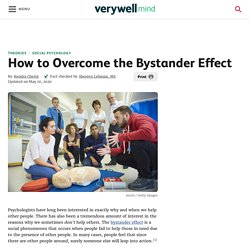

To counteract, we need to be fully aware that this effect is real and unconsciously when we are a part of a large crowd, it seems like no single person has to take responsibility for an action (or inaction).
Below are informations and articles of what bystander effect really means. Being part of a large crowd makes it so no single person has to take responsibility for an action (or inaction)
What Is the Bystander Effect? If you witnessed an emergency happening right before your eyes, you would certainly take some sort of action to help the person in trouble, right?

While we might all like to believe that this is true, psychologists suggest that whether or not you intervene might depend upon the number of other witnesses present. Darley Latane 1968. Chapter 5: Experimental Research – Research Methods in Psychology. In the late 1960s social psychologists John Darley and Bibb Latané proposed a counter-intuitive hypothesis.

The more witnesses there are to an accident or a crime, the less likely any of them is to help the victim (Darley & Latané, 1968). They also suggested the theory that this phenomenon occurs because each witness feels less responsible for helping—a process referred to as the “diffusion of responsibility.” Darley and Latané noted that their ideas were consistent with many real-world cases.
For example, a New York woman named Catherine “Kitty” Genovese was assaulted and murdered while several witnesses evidently failed to help. But Darley and Latané also understood that such isolated cases did not provide convincing evidence for their hypothesized “bystander effect.” So to test their hypothesis, Darley and Latané created a simulated emergency situation in a laboratory.
In actuality, there were no other students. The Parable of the 38 Witnesses. Bystander Effect: What Is It and What You Can Do About It. What the bystander effect looks like A little after 3 a.m. on March 13, 1964, Catherine “Kitty” Genovese parked her car and walked to her apartment in Queens, New York, after finishing her shift as a bar manager.
Serial killer Winston Moseley was out to victimize someone that night. Genovese became his target. When he followed her, she ran. As Moseley reached her and began stabbing her with a hunting knife, Genovese screamed, “Oh, my God, he stabbed me! When lights in surrounding apartments flipped on and one man called out his window, the attacker ran and hid in the shadows. There was widespread public condemnation of the witnesses who did not come to Kitty Genovese’s aid.
The related terms “bystander effect” and “diffusion of responsibility” were coined by social psychologists as a result of this research. How to Overcome the Bystander Effect. Psychologists have long been interested in exactly why and when we help other people.

There has also been a tremendous amount of interest in the reasons why we sometimes don't help others. The bystander effect is a social phenomenon that occurs when people fail to help those in need due to the presence of other people. In many cases, people feel that since there are other people around, surely someone else will leap into action.1 While the bystander effect can have a negative impact on prosocial behavior, altruism and heroism, researchers have identified a number of different factors that can help people overcome this tendency and increase the likelihood that they will engage in helping behaviors.2 Some of these include: Witnessing Helping Behavior Sometimes just seeing other people doing something kind or helpful makes us more willing to help others.
Imagine that you are walking into a large department store. Being Observant Being Skilled and Knowledgeable Guilt Feeling Good. Bystander Effect Demonstrates That People Help Each Other. The antidote to the bystander effect lies in one of the many questions we ask ourselves: Are other people in the group aware of me?

Most of the time, we see ourselves as invisible members of the group; we’re part of the collective but not singled out. When we begin to feel that the group is aware of us personally, then we decide to take action. For example, if I knew that a TV camera would air video footage of me driving past the vehicle in distress, I would be much more likely to stop and help. Psychologists call this “public self-awareness” and it’s the key to reversing the bystander effect. A group of Dutch psychologists, led by Marco van Bommel, designed a clever and incredibly simple way to test public self-awareness in a bystander situation online.
Finally, the researchers added one small feature to make the study participants publicly self-aware: In a public list of people in the community, the participant’s name was highlighted in a red font.